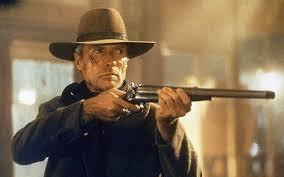What Makes a Reader Keep Turning Pages?
We were talking last week about the storytelling concept of the Inciting Incident. We said that this week we’d get into the two “narrative poles” that spring into being the instant this scene is introduced.

Clint Eastwood in “Unforgiven.” Will he remain true to his beloved wife’s wish that he become a good man?
What we’re talking about here is the architecture of a story.
Architecture is not the same as genius. It’s not the unique brilliance that you the writer bring to your dialogue. It’s not the one-of-a-kind twists and spins that you alone can insert into your narrative. It’s not the dazzling characters or relationships that you and only you can deliver.
It’s more important than that.
It’s the structure of the bridge you’re building.
It’s the foundation of the skyscraper.
It’s the design of the rocket ship.
What we’re talking about is the architectural superstructure onto which you the writer will hang all your scenes and sequences and characters and relationships.
Okay. How does the Inciting Incident fit into this concept of Story Architecture?
Have you watched any of Aaron Sorkin’s MasterClass on Screenwriting? (I highly recommend it.) Mr. Sorkin’s central storytelling concept is the idea of Intention and Obstacle.
The protagonist has an intention. Obstacles try to stop him or her from achieving this. What he/she does to overcome these obstacles is what produces drama.
(There, I just saved you ninety bucks.)
The Inciting Incident is the moment when the hero acquires his or her intention.
Jason Bourne realizes he is a very specific someone—a spy? a killer?—but he has lost all memory; he must find out who he is. Nine-year-old Addie Loggins in Paper Moon decides she wants to be with her Pa and she is convinced that Moses Pray is that person. Rocky decides he’s gonna fight the champ. Mark Watney decides he’s going to escape death on Mars.
These moments are Pole Number One of our story’s architecture.
Pole Number Two is the Object itself.
Between the two, immediately springing to life, is the Big Narrative Question, the issue that will keep the reader turning pages and hold him or her riveted to your story.
Will Jason Bourne find out who he is? How will he do it? Who, in fact, is he?
Will Addie Loggins find a home with her pa, Moses Pray?
Will Rocky stand up to the champ?
Will Mark Watney return safely to Earth?
The Inciting Incident sets up both poles:
The moment when the hero acquires a burning, life-and-death intention.
The yet-to-be-revealed success or failure of this intention.
Aaron Sorkin tells us that a story’s drama is created by the obstacles that the hero must overcome to reach his or her objective.
The desire to find out how he or she does this is what keeps us, the audience, glued to our seats.
It’s what keeps us, the readers, turning pages.
Will Shane succeed in hanging up his guns and settling down in the valley?
Will Jake Gittes find out who played him for a sucker with the phony Mrs. Mulwray?
Will gunfighter William Munny remain true to his dead wife’s wish for him to become a good man?
The inciting incident is Pole Number One of this story architecture. The instant it appears, it sets up Pole Number Two, which we the audience can feel, ahead at the story’s climax, and which electrifies us.
A great inciting incident gives us gooseflesh. We think to ourselves, “Wow, this story is cooking! I can’t wait to see how it turns out.”
A great incident sets up a Narrative Question that we the readers can’t resist.
A great inciting incident establishes an almost electromagnetic tension between the two poles, one at the start of the story (which we the readers now know) and one at the end, which is yet to be revealed.
We keep turning pages to get to that second pole.
Next week: the climax is embedded in the Inciting Incident.



